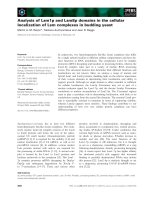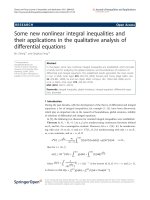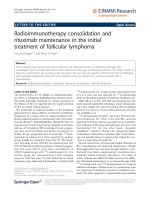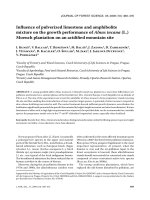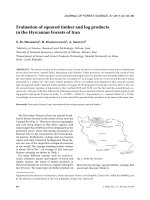Xylanase and phytase supplementation in the de-oiled rice bran (DORB) based diet improves the growth performance of Labeo rohita
Bạn đang xem bản rút gọn của tài liệu. Xem và tải ngay bản đầy đủ của tài liệu tại đây (311.44 KB, 11 trang )
Int.J.Curr.Microbiol.App.Sci (2017) 6(6): 1493-1503
International Journal of Current Microbiology and Applied Sciences
ISSN: 2319-7706 Volume 6 Number 6 (2017) pp. 1493-1503
Journal homepage:
Original Research Article
/>
Xylanase and Phytase Supplementation in the De-oiled Rice Bran (DORB)
based Diet Improves the Growth Performance of Labeo rohita
Amit Ranjan, Narottam Prasad Sahu*, Ashutosh Dharmendra Deo,
H. Sanath Kumar, Sarvendra Kumar and Kamal Kant Jain
Central Institute of Fisheries Education, Mumbai, India
*Corresponding author
ABSTRACT
Keywords
De-oiled Rice bran
(DORB), Labeo
rohita, Xylanase,
Phytase, Growth,
Body composition.
Article Info
Accepted:
21 May 2017
Available Online:
10 June 2017
A 60-day experiment was conducted to study the effect of xylanase and phytase
supplementation in the DORB based diet on growth performance of Labeo rohita.
Two iso-nitrogenous (crude protein-14%) test diets (T1-DORB based diet, T2phytase and xylanase supplemented diet) were formulated. Sixty (60) juveniles of
L. rohita, with an average weight 5.01±0.02g were stocked in six uniform size
plastic rectangular tank in triplicates with 10 fishes per tank following a
completely randomized design (CRD). At the end of the experiment growth
performance and nutrient utilization of L. rohita were assessed and found that
exogenous enzyme supplementation @ 0.01% in the DORB based diet
significantly (p<0.05) improved the growth performance and nutrient utilization
(weight gain % from 63.6% to 79.7%, SGR from 0.82 to 0.98, PER from 2.01 to
2.44 and FCR reduced from 3.57 to 2.92) of L. rohita. Carcass composition of
fishes did not vary significantly. Hence, the experiment concludes that exogenous
enzyme supplementation of xylanase and phytase in the DORB based diet
improves the growth performance of L. rohita.
Introduction
De-oiled rice bran (DORB) is one of the
major ingredient used in the fish feed. DORB
is the by-product after extraction of oil from
rice bran. At present about 7.0 MT of
ingredients are being used for farm-made fish
production (Ramakrishna et al., 2013). The
current aquaculture production of the country
(4.3 MMT) which is projected to reach 12.7
MMT by the year 2030 as reported by World
Bank report (Msangi et al., 2013).
Considering the total aquafeed production of
India which is about 1 MMT as reported by
Alltech (2014) is set to reach around 3 MMT
by the year 2030 but the feed demand will be
around 23 MMT hence the major part of feed
will be the Mash feed that mainly contains
DORB (about 80-85 %) (Ramkrishna et al.,
2013). The carps together contribute to more
than 82% of total aquaculture production in
India. About 97% of the carp feeds used by
Indian farmers are farm-made (Ramkrishna et
al., 2013). But looking into the DORB
production of India which is presently about 6
MMT is not going to increase to support the
1493
Int.J.Curr.Microbiol.App.Sci (2017) 6(6): 1493-1503
demand that will be required for Indian Major
Carp (IMC) and other cultured fish. Hence,
the strategic utilization of DORB to reduce
FCR is required which will pave the way to
bring down the demand and supply gap of
DORB.
Most of the ANFs present in rice bran is
protein in nature and heat labile except
phytate (Juliano, 1985). Rice bran also
contains a relatively high percentage of nonstarch polysaccharide (NSP), with arabinose
and xylose being predominant (Annison et al.,
1985). This may have an adverse effect on the
digestion of some dietary components. Phytic
acid is an ANF found in many plant
ingredients which chelate with various macroand micronutrients and negatively affects
their digestibility (Sugiura et al., 2001;
Usmani and Jafri, 2002; Baruah et al., 2005,
2007; Debnath et al., 2005). Dietary microbial
phytase supplementation has been shown to
be very promising in several fish species
which nullify the negative effect of phytate
and improves the nutrients digestibility and
growth performance of fish (Yan and Reigh,
2002; Vielma et al., 2004; Debnath et al.,
2005; Baruah et al., 2007).
Non-starch polysaccharide (NSP) are
considered as an unavailable energy source
for fish, as they lack NSP digestive enzymes
(Castillo and Gatlin, 2015; Sinha et al., 2011).
NSP dilutes the energy concentration of the
feeds
and
reduces
the
digestibility/bioavailability of nutrients by
interfering with the digestion and absorption
(NRC, 2011; Castillo and Gatlin, 2015). NSP
also interfere with the access of digestive
enzymes to their substrates (Xu et al., 2009;
Jiang et al., 2014; Magalhães et al., 2015).
Dietary NSPase supplementation to plant
based feedstuffs diets improves nutrients
utilization and reduces environmental faecal
wastes. NSPase were shown to increase the
growth performance, feed conversion, and
protein utilization efficiency in juvenile
Japanese seabass (Lateolabrax japonicas; Ai
et al., 2007), hybrid tilapia (Oreochromis
niloticus × Oreochromis aureus; Lin et al.,
2007); Caspian salmon (Salmo trutta caspius;
Zamini et al., 2014) and African catfish
(Clarias gariepinus; Yildirim and Turan,
2010). The beneficial effects of exogenous
non-starch polysaccharidases (NSPase) may
be directly related to NSP hydroxylation,
which improves carbohydrate digestibility, or
to the improvement of other nutrients
digestibility (Adeola and Bedford, 2004; Ai et
al., 2007; Adeola and Cowieson, 2011; Yiğit
et al., 2014). Xylanase hydrolyses cell wall
components in plant and efficiently reduces
NSP content in plant ingredient which in turn
improves protein utilization and growth
performance in several fish experiment.
As it is clear from above discussion that
DORB contains various ANFs, NSP that
impede the nutrient utilization of rice bran.
Hence, to increase the nutrient availability
and improve the growth performance and
nutrient utilization of Labeo rohita, the
present study has conducted to evaluate the
effect
of
xylanase
and
phytase
supplementation on maximizing utilization of
de-oiled rice bran in the diet of Labeo rohita.
Materials and Methods
De-oiled Rice bran
De-oiled rice bran was supplied by Vaighai
Agro Products Ltd., Tamil Nadu, India.
Before using de-oiled rice bran in feed, it was
finely ground and sieved to get uniform
particle size.
Exogenous enzymes
Microbial phytase from E. coli (Quantum
blue, 500 U/ kg) and xylanase (Econase® XT,
1494
Int.J.Curr.Microbiol.App.Sci (2017) 6(6): 1493-1503
16000 U/ kg) was supplied by AB Vista,
Wiltshire, UK.
Diet preparation
The experimental diets were prepared using
DORB. Two experimental diets (T1 and T2)
were prepared using ingredients given in table
1. Diets were prepared by blending the
ingredients except the vitamin mineral mix to
make a dough with the water. Then it was
steamed for 30 min. in a pressure cooker.
After cooling the dough, vitamin-mineral mix,
oil and enzymes were added to the different
diets as specified in the formulation. The
dough was then mixed properly and pressed
through
a
semi-automatic
pelletizer
(Uniextrude-Single screw extruder S.B.
Panchal and Company, Mumbai, India) to get
uniform sized pellets (0.7-0.8 mm), which
were spread on a sheet of paper and dried at
room temperature. After drying, the pellets
were packed in polythene bags, sealed and
kept at -20°C for storage until use.
Fish and facilities
The experiment was conducted at wet
laboratory of the CIFE, Mumbai over a period
of 60 days from February to April, 2016.
Subsequently, the laboratory work was
carried out in Fish Nutrition, Biochemistry
and Physiology laboratory of Central Institute
of Fisheries Education. Experimental fishes
were procured from a commercial farm from
Shramjivi Janta Sahayak Mandal (NGO)
Taluka-Mahad, District-Raigarh, Mumbai.
The fishes were transported to the wet
laboratory in oxygen packed polyethylene
bags. In order to ameliorate the handling
stress the fishes were given a mild salt (4
ppm) treatment and vitamin C (4 tablets per
500 lit of water) treatment the next day. The
stock was acclimatized for a period of 30 days
before start of the experiment. Animals used
for the experiment were juveniles of Labeo
rohita, with an average weight 5.01±0.02g
(4.9g-5.1g). The experimental setup consisted
of 6 uniform size plastic rectangular tank (80
cm × 57 cm × 42 cm, 150 L capacity) covered
with perforated lids. Sixty (60) fishes were
randomly distributed and stocked in two
distinct experimental groups following a
completely randomized design (CRD) in
triplicates with 10 fishes per tank.The total
volume of the water in each tub was
maintained at 120L throughout the
experimental period. Round the clock aeration
was provided. The aeration pipe in each tank
was provided with an air stone and a plastic
regulator to control the air pressure uniformly
in all the tanks. Feed was fed ad libitum twice
daily at 10:00 am in the morning and 04:00
pm in the afternoon. Water quality parameters
like DO, pH, free CO2, hardness, ammonia,
nitrite and nitrate were also estimated
periodically as per APHA method (APHA,
1998) to keep the water quality optimal for
sustained culture of fish.
Fish sampling and proximate analysis
At the end of feeding trial fishes were fasted
for the 24 hrs. and then weighed for
calculating the growth performance and
nutrient utilization parameters like weight
gain (%), specific growth rate (SGR), feed
conversion ratio (FCR), protein efficiency
ratio (PER). Body indices parameters like
hepato-somatic index and intestine-somatic
index was also calculated by taking liver and
intestine weight to whole body weight of six
fishes per replicate. Survival (%)was
calculated at the end of experiment by
dividing total no. of fish harvested at the end
of experiment to the total number of fish
stocked at the beginning of the experiment
multiplied by 100.Six fish per replicate were
sampled and anesthetized with clove oil (50
µl.L-1) before killing the fish. For proximate
analysis all the dissected fishes from every
replicate were collected, weighed and kept in
pre-weighed petri plates. Prior to proximate
analysis the test diets and sampled fish in
1495
Int.J.Curr.Microbiol.App.Sci (2017) 6(6): 1493-1503
triplicates were dried in hot air oven at 100°C
±2. After complete drying the different test
diets and fishes were ground into the fine
powder with a pestle and mortar. Proximate
composition of the test diets and fish were
analyzed following AOAC method (AOAC,
1995).
Calculations
Weight gain (%), specific growth rate (SGR),
feed conversion ratio (FCR), protein
efficiency ratio (PER), hepato-somatic index
(HSI), intestinal-somatic index (ISI) and
survival (%) were calculated as given below
hardness (228-240 mg.L-1), ammonia (0.140.19 mg.L-1), nitrite (0.001-0.002 mg.L-1) and
nitrate (0.02-0.04 mg.L-1).
Proximate composition of Experimental
diets
Proximate composition of the experimental
diets viz. dry matter(%),ash (%), crude
protein (%),ether extract (%) and crude fibre
(%) were analysed which is presented in table
2. Dry matter (%) vary from 92.30 % to 92.39
%, ash (%) vary from 13.70 % to
13.79%,crude protein (%) vary from 14.02%
to 14.15 %, ether extract (%) vary from 7.44
% to 7.50 % and crude fibre (%) vary from
16.12% to 16.41 % which were found
statistically insignificant (p>0.05) among
treatments.
Growth performance, nutrient utilization,
body indices and survival (%) of different
treatments
Highest WG %, SGR and PER and lowest
FCR were recorded for the fishes fed with
DORB supplemented with exogenous
enzymes (phytase and xylanase), as compared
to the fish fed with the only DORB without
enzyme supplementation. Exogenous enzyme
supplementation
to
DORB
resulted
improvement in weight gain % from 63.6% to
79.7%, SGR from 0.82 to 0.98, PER from
2.01 to 2.44 and FCR reduced from 3.57 to
2.92 of L. rohita. Body indices parameter like
HSI varied from 0.61 to 0.74 and ISI varied
from 3.87 to 4.04 which were not statistically
different treatments. Survival (%) of the two
treatments were 100 % (T1) and 93% (T2)
which were not significantly different
(p>0.05) (Table 3).
Results and Discussion
Water quality Parameter
Water quality parameters were estimated
periodically as per APHA method (APHA,
1998) and the range of all parameter observed
during experimental period were as follows:
temperature (27.2-28 °C), DO (6.5-7.2 mgL-1),
pH (7.5-7.6), free CO2 (not detected),
Body composition of fishes among different
treatments
Proximate composition of the whole body of
fish is presented in table 4. Body composition
1496
Int.J.Curr.Microbiol.App.Sci (2017) 6(6): 1493-1503
of fishes were analysed following AOAC
method (AOAC, 1995) in which moisture (%)
of fishes varies from 76.05 to 76.42 %,crude
protein from 13.17% to 13.99, ssh (%) from
3.56% to 3.58%,and ether extract from 3.01%
to 3.23% which were also not different among
treatments (p>0.05).
Higher crude fibre content and non-starch
polysaccharide along with phytate are the
major limitation for utilization of DORB in
the mono-gastric animal including fish. The
non-starch
polysaccharide
altogether
constitutes 59.97% of the DORB (Malathi and
Devegowda, 2001), which is not digested by
fish (Francis et al., 2001; Glencross et al.,
2007). The presence of NSP in the diets leads
to increase gut viscosity, prevent access to the
endogenous enzyme to nutrients and form a
physical barrier and hence elicit an antinutritive effect (Storebakken et al., 1998;
Refstie et al., 1999).
Table.1 Composition of experimental diets
Ingredients (%)
T1
T2
DORB
CMC
Cod liver oil
Soybean oil
Vitamin- mineral mix
Phytase
90
2
3.5
3.5
1
0
90
2
3.5
3.5
1
0.01
Xylanase
0
0.01
T1- DORB without enzyme, T2- DORB with enzyme
DORB= De-0ioled Rice Bran, CMC= Carboxy Methyl Cellulose
Composition of Vitamin- mineral mix (PREMIX PLUS) (quantity.kg-1)
Vitamin A (55,00,000 IU); Vitamin D3 (11,00,000 IU); Vitamin B2 (2,000 mg); Vitamin E (750 mg); Vitamin K
(1,000 mg); Vitamin B1 (100 mg), Vitamin B2 (200 mg), Vitamin B6 (1,000 mg); Vitamin B12 (6 mcg); Calcium
Pantothenate (2,500 mg); Nicotinamide (10 g); Choline Chloride (150 g); Mn (27,000 mg); I (1,000 mg); Fe (7,500
mg); Zn (5,000 mg); Cu (2,000 mg); Co (450) (10g);Selenium(125mg).
Table.2 Proximate composition of Test Diets (% Dry matter basis)
Proximate composition
Dry matter
Ash
CP
EE
CF
T1
92.30±0.22
13.79±0.03
14.02±0.03
7.50±0.02
16.12±0.20
T2
92.39±0.26
13.70±0.08
14.15±0.10
7.44±0.17
16.41±0.02
T1- DORB without enzyme, T2- DORB with enzyme
All values are Mean ± SE, obtained from three replicates.
CP (%) =Crude Protein; EE (%) =Ether Extract; CF (%) =Crude Fibre; SE=Standard Error.
1497
Int.J.Curr.Microbiol.App.Sci (2017) 6(6): 1493-1503
Table.3 Growth performance, Body indices and Survival (%) of Labeo rohita fed with or
without enzyme supplemented DORB
Treatments
T1
T2
a
p-value
b
WG%
63.61 ±2.66
79.71 ±1.20
0.005
SGR
0.82a±0.03
0.98b±0.01
0.006
FCR
3.57b±0.13
2.92a±0.04
0.008
PER
2.01a±0.07
2.44b±0.03
0.005
HSI
0.61±0.05
0.74±0.03
0.095
ISI
3.87±0.15
4.04±0.32
0.661
Survival %
100
93
0.374
T1- DORB without enzyme, T2- DORB with enzyme
All values are Mean ± SE, obtained from three replicates. Values in the same row with different superscript letters
are significantly different (p< 0.05).
WG %= Weight Gain %, SGR= Specific Growth Rate, FCR=Feed Conversion Ratio, PER= Protein Efficiency
Ratio, HSI = hepato-somatic index, ISI= intestinal-somatic index, SE=Standard Error.
Table.4 Whole body composition of Labeo rohita fed with or without
Enzyme supplemented DORB
Treatments
T1
T2
p-value
Moisture (%)
76.05±0.51
76.42±0.14
0.521
CP (%)
13.17±0.32
13.99±0.23
0.105
ASH (%)
3.56±0.19
3.58±0.16
0.955
EE (%)
3.23±0.17
3.01±0.24
0.092
T1- DORB without enzyme, T2- DORB with enzyme
CP (%) =Crude Protein; EE (%) =Ether Extract; SE=Standard Error.
In fish, their negative influences may be
either because of binding to bile acids or
obstructing action against digestive enzyme
activity and movement of substrates in their
intestine (Storebakken et al., 1998). Digestive
enzymes in fish that specifically hydrolyze
the β-glycosidic bonds of non-starch
polysaccharides are very low or even nonexistent (Krogdahl et al., 2005; NRC, 2011).
Supplementation of exogenous NSP enzymes
leads to the decrease in digesta viscosity, and
improve digestibility of amino acids, protein,
lipid and starch which contributes to
improved feed utilization and growth
performance of animals (Classen, 1996;
Cowieson et al., 2006). Phytate is another
important anti-nutritional factor which is
associated with DORB. Phytate chelates with
divalent element such as Ca2+, Zn2+, Fe2+,
Mn2+ and forms insoluble chelate complex
(Papatryphon et al., 1999).
They also combine with protein insoluble
complex and reduce their utilization
efficiency, activity and digestibility (Liu et
al., 1998; Sugiura et al., 2001). Fishes are
unable to digest Phytate phosphorus as they
are devoid of intestinal phytase (Pointillart et
al., 1987; Debnath et al., 2005). The
exogenous phytase supplementation leads to
increase in the utilization of phytate
phosphorus, other trace elements and protein,
1498
Int.J.Curr.Microbiol.App.Sci (2017) 6(6): 1493-1503
and the decrease in phosphorus discharged
into water (Papatryphon et al., 1999; Vielma
et al., 2002). Results from the present study
demonstrated that strategy like exogenous
enzyme supplementation to DORB based diet
improves the growth performance and
nutrient utilization of L. rohita significantly.
The exogenous enzyme supplementation to
the DORB based diet led to higher weight
gain, SGR, PER and lower FCR as compared
to the DORB based diet in which exogenous
enzyme was not supplemented. Similar,
findings were also observed in Japanese sea
bass, Lateolabrax japonicus (Ai et al., 2007;
Zhang et al., 2009) large yellow croaker,
Pseudosciaenacrocea (Zhang et al., 2006)
and tilapia, Oreochromis niloticus ×
Oreochromis aureus (Lin et al., 2007), when
their diet supplemented with exogenous nonstarch polysaccharide (NSP) enzymes and
phytase, resulted in higher growth, feed
utilization and digestive enzyme activities.
Zamini et al., (2014) also found that Salmo
trutta caspius fed the control diet without any
exogenous enzyme exhibited lower growth
and higher FCR than diets with supplemented
enzymes, indicating that exogenous enzyme is
beneficial for the growth of the fish. Most
studies on other species also indicated that
exogenous carbohydrases enzymes improved
the weight gain and feed conversion ratio
(Carter et al., 1994; Van et al., 1999; Bedford,
1995, 2000; Hlophe-Ginindza et al., 2015). In
contrary to that there are several conflicting
reports in which it was found that even no or
adverse effect when carbohydrases enzymes
were added to the animal feeds (Stone et al.,
2003; Kazerani and Shahsavani, 2011; Yigit
and Olmez, 2011). Similarly, Ogunkoya et al.,
(2006) and Farhangi and Carter (2007) did not
find any effect on growth and feed efficiency
of rainbow trout fed the diet supplemented
with enzyme cocktail mix. HSI explains the
relationship between liver weight and body
weight. In present study, HSI did not vary
significantly among the treatments, which is
in accordance with the finding of Magalhães
et al., (2016), who also observed no
significant difference in the HSI of white
seabream (Diplodussargus) juveniles fed high
soybean meal diets supplemented with
exogenous carbohydrases enzyme. Similarly,
ISI explains the relationship between the
weight of intestine and somatic weight of the
fish. In present study, ISI were found similar
(p>0.05). Fawole et al., (2016) also did not
find any significant difference in the ISI of
Labeorohita fed with rubber protein isolate.
The whole body moisture %, ash %, crude
protein % and ether extract % was similar
among treatments (p>0.05). Our findings are
consistent with the results of Adeoye et al.,
(2016), however, he finds a significant
difference in moisture % when he fed
formulated diet to tilapia with selected
exogenous enzymes (Protease, lipase and
Carbohydrases). Similarly, Yldirin and Turan
(2010) also observed no significant difference
in the whole body composition except crude
protein (%) of Clarius gariepinus fed with
exogenous enzyme supplemented diet.
The addition of xylanase and phytase @ 0.01
% to the DORB based diets significantly
improved the growth performance and
nutrient utilization of Labeorohita. The
present study demonstrated that DORB based
diet along with supplementation of exogenous
enzymes (xylanase and phytase) can be an
effective strategy to bring down the FCR,
which will not only bring down the future
higher demand of DORB but will also give an
effective tool to utilize DORB as sole source
of ingredient in the feed of Labeorohita. This
appears to be an effective strategy for
utilization of farm feed which is mostly
prepared from DORB.
Acknowledgements
The authors are very thankful to the Director,
Central Institute of Fisheries Education,
Versova, Mumbai, for providing all the
1499
Int.J.Curr.Microbiol.App.Sci (2017) 6(6): 1493-1503
facilities during the research work. The
financial support given by the Indian Council
of Agricultural Research, New Delhi, is also
gratefully acknowledged. The authors are also
sincerely acknowledging the support of
Vaighai Agro Products Limited, Tamil Nadu
and AB Vista, India for supplying DORB and
Enzymes free of cost for successful
completion of this research work. First
Authors is sincerely acknowledging the Dr.
C.V. Kulkarni International Travel Grant
which makes it possible for the first author to
present his research paper during International
Fisheries Symposium, 2016 at Phu Quoc
Island, Vietnam.
References
Adeola, O. and Bedford, M.R. 2004.
Exogenous dietary xylanase ameliorates
viscosity-induced anti-nutritional effects
in wheat-based diets for White Pekin
ducks (Anas platyrinchos domesticus).
Br. J. Nutr., 92: 87-94.
Adeola, O. and Cowieson, A.J. 2011.
Opportunities and challenges in using
exogenous enzymes to improve nonruminant animal production. J. Anim.
Sci., 89: 3189–3218.
Adeoye, A.A., Jaramillo-Torres, A., Fox,
S.W., Merrifield, D.L. and Davies, S.J.
2016. Supplementation of formulated
diets for tilapia (Oreochromis niloticus)
with selected exogenous enzymes:
Overall performance and effects on
intestinal histology and microbiota.
Anim. Feed. Sci. Tech., 215: 133-143.
Ai, Q., Mai, K., Zhang, W., Xu, W., Tan, B.,
Zhang, C. and Li, H. 2007. Effects of
exogenous enzymes (phytase, nonstarch polysaccharide enzyme) in diets
on growth, feed utilization, nitrogen and
phosphorus excretion of Japanese
seabass, Lateolabrax japonicus. Comp.
Biochem. Physiol., 147: 502–508.
Akhtar, M.S., Pal, A.K., Sahu, N.P., Ciji, A.,
and Meena, D.K. 2012. Effects of
dietary Pyridoxine on growth and
physiological responses of Labeo rohita
fingerlings reared in high water
temperature. Israeli J. Aquacult., 64: 16.
Alltech. 2014. Alltech Global Feed Survey
Summary, 8p. Alltech Nicholasville,
Kentucky, USA.
Annison, G., Moughan, P.J. and Thomas, D.
V. 1995. Nutritive activity of soluble
rice bran arabinoxylans in broiler diets.
Br. Poult. Sci., 36: 479-488.
AOAC (Association of Official Analytical
Chemists). 1995. Official Methods of
Analysis of the Association Official
Analytical Chemists, 16th ed. AOAC,
Inc., Arlington, Virginia, USA.
APHA. 1998. Standard Methods for the
Examination of Water and Wastewater,
Washigton, DC, 20th Edition, pp.1220.
Baruah, K., Pal, A.K., Sahu, N.P., Jain, K.K.,
Mukherjee, S.C., and Debnath, D. 2005.
Dietary protein level, microbial phytase,
citric acid and their interactions on bone
mineralization
of
Labeo
rohita
(Hamilton) juveniles. Aquacult. Res.,
36: 803-812.
Baruah, K., Sahu, N.P., Pal, A.K., Jain, K.K.,
Debnath, D. and Mukherjee, S.C. 2007.
Dietary microbial phytase and citric
acid synergistically enhances nutrient
digestibility and growth performance of
Labeo rohita (Hamilton) juveniles at
sub‐ optimal protein level. Aquacult.
Res., 38: 109-120.
Bedford, M.R. 2000. Exogenous enzymes in
monogastric nutrition—their current
value and future benefits. Anim. Feed.
Sci. Tech., 86:1-13.
Bedford, M.R. 1995. Mechanism of action
and potential environmental benefits
from the use of feed enzymes. Anim.
Feed. Sci. Tech., 53: 145-155.
1500
Int.J.Curr.Microbiol.App.Sci (2017) 6(6): 1493-1503
Carter, C.G., Houlihan, D.F., Buchanan, B.
and Mitchell, A.I. 1994. Growth and
feed utilization efficiencies of seawater
Atlantic salmon, Salmo salar L., fed a
diet containing supplementary enzymes.
Aquacult. Res., 25: 37-46.
Classen, H.L. 1996. Cereal grain starch and
exogenous enzymes in poultry diets.
Anim. Feed. Sci. Technol., 62: 21–27
Cowieson, A.J., Singh, D.N. and Adeola, O.
2006. Prediction of ingredient quality
and the effect of a combination of
xylanase, amylase, protease and phytase
in the diets of broiler chicks. 1. Growth
performance and digestible nutrient
intake. Br. Poult. Sci., 47: 477-489.
Debnath, D., Pal, A.K., Sahu, N.P., Jain,
K.K., Yengkokpam, S. and Mukherjee,
S.C. 2005. Effect of dietary microbial
phytase supplementation on growth and
nutrient digestibility of Pangasius
pangasius
(Hamilton)
fingerlings.
Aquacult. Res., 36: 180-187.
Fawole, F.J., Sahu, N.P., Jain, K.K., Gupta,
S., Shamna, N., Phulia, V., and Prabu,
D.L. 2016. Nutritional evaluation of
protein isolate from rubber seed in the
diet of Labeo rohita: Effects on growth
performance, nutrient utilization, whole
body composition and metabolic
enzymes activity. Anim. Feed. Sci.
Tech., 219: 189-199.
Francis, G., Makkar, H.P. and Becker, K.
2001. Anti-nutritional factors present in
plant-derived alternate fish feed
ingredients and their effects in fish.
Aquaculture, 199: 197-227.
Glencross, B.D., Booth, M. and Allan, G.L.
2007. A feed is only as good as its
ingredients–a review of ingredient
evaluation strategies for aquaculture
feeds. Aquac. Nutr., 13: 17-34.
Hlophe Ginindza, S.N., Moyo, N.A., Ngambi,
J.W. and Ncube, I. 2015. The effect of
exogenous enzyme supplementation on
growth performance and digestive
enzyme activities in Oreochromis
mossambicus fed kikuyu‐ based diets.
Aquac. Res., 1-11.
Jiang, T.T., Feng, L., Liu, Y., Jiang, W.D.,
Jiang, J., Li, S.H., Tang, L., Kuang,
S.Y. and Zhou, X.Q. 2014. Effects of
exogenous xylanase supplementation in
plant protein-enriched diets on growth
performance,
intestinal
enzyme
activities and microflora of juvenile Jian
carp (Cyprinus carpio var. Jian). Aquac.
Nutr., 20: 632–645.
Kazerani, H.R. and Shahsavani, D. 2011. The
effect of supplementation of feed with
exogenous enzymes on the growth of
common carp (Cyprinus carpio). Iran. J.
Vet. Res., 12: 127-132.
Krogdahl, Å., Hemre, G.I. and Mommsen,
T.P. 2005. Carbohydrates in fish
nutrition: digestion and absorption in
post-larval stages. Aquac. Nutr., 11:
103-122.
Lin, S., Mai, K. and Tan, B. 2007. Effects of
exogenous enzyme supplementation in
diets on growth and feed utilization in
tilapia, Oreochromis niloticus x O.
aureus. Aquac. Res., 38: 1645-1653.
Liu, B.L., Rafiq, A., Tzeng, Y.M. and Rob, A.
1998.
The
induction
and
characterization of phytase and beyond.
Enzyme Microb. Technol., 22: 415-424.
Magalhães, R., Coutinho, F., Pousão-Ferreira,
P., Aires, T., Oliva-Teles, A. and Peres,
H. 2015. Corn distillers dried grains
with solubles: Apparent digestibility
and digestive enzymes activities in
European
seabass
(Dicentrarchus
labrax) and meagre (Argyrosomus
regius). Aquaculture, 443: 90-97.
Magalhães, R., Lopes, T., Martins, N., DíazRosales, P., Couto, A., Pousão-Ferreira,
P., and Peres, H. 2016. Carbohydrases
supplementation increased nutrient
utilization in white seabream (Diplodus
sargus) juveniles fed high soybean meal
diets. Aquaculture, 463: 43-50.
1501
Int.J.Curr.Microbiol.App.Sci (2017) 6(6): 1493-1503
Malathi, V., and Devegowda, G. 2001. In
vitro
evaluation
of
nonstarch
polysaccharide digestibility of feed
ingredients by enzymes. Poult. Sci., 80:
302-305.
Msangi, S., Kobayashi, M., Batka, M.,
Vannuccini, S., Dey, M.M. and
Anderson, J.L. 2013. Fish to 2030:
prospects for fisheries and aquaculture.
World Bank Report, (83177-GLB).
National Research Council. 2011. Nutrient
requirements of fish and shrimp.
National academies press.
Ogunkoya, A.E., Page, G.I., Adewolu, M.A.
and Bureau, D.P. 2006. Dietary
incorporation of soybean meal and
exogenous enzyme cocktail can affect
physical characteristics of faecal
material egested by rainbow trout
(Oncorhynchus mykiss). Aquaculture,
254: 466-475.
Papatryphon, E., Howell Jr., and R.A., J.H.S.
1999. Growth and mineral absorption
by striped bass Moronesaxatilis fed a
plant feedstuff based diet supplemented
with phytase. J. World Aquacult. Soc.,
30: 161–173.
Ramakrishna, R., Shipton, T.A. and Hasan,
M.R. 2013. Feeding and feed
management of Indian major carps in
Andhra Pradesh, India. Food and
Agriculture Organization of the United
Nations.
Refstie, S., Svihus, B., Shearer, K.D. and
Storebakken,
T.
1999.
Nutrient
digestibility in Atlantic salmon and
broiler chickens related to viscosity and
non-starch polysaccharide content in
different soyabean products. Anim. Feed
Sci. Technol., 79: 331–345.
Stone, D.A.J., Allan, G.L. and Anderson, A.J.
2003. Carbohydrate utilization by
juvenile
silver
perch,
Bidyanus
bidyanus (Mitchell). IV. Can dietary
enzymes increase digestible energy
from wheat starch, wheat and dehulled
lupin? Aquac. Res., 34: 135-147.
Storebakken, T., Shearer, K.D. and Roem, A.
J. 1998. Availability of protein,
phosphorus and other elements in fish
meal, soy-protein concentrate and
phytase-treated soy-protein-concentratebased diets to Atlantic salmon, Salmo
salar. Aquaculture, 161: 365-379.
Sugiura, S.H., Gabaudan, J., Dong, F.M. and
Hardy, R.W. 2001. Dietary microbial
phytase supplementation and the
utilization of phosphorus, trace minerals
and protein by rainbow trout
Oncorhynchus mykiss (Walbaum) fed
soybean meal based diets. Aqua. Res.,
32: 583-592.
Usmani, N. and Jafri, A.K. 2002. Influence of
dietary phytic acid on the growth,
conversion efficiency, and carcass
composition of mrigal Cirrhinus
mrigala (Hamilton) fry. J. World Aqua.
Soc., 33: 199-204.
Van, W.J.H., Khalaf, K.A., Aartsen, F.J. and
Tijssen, P.A.T. 1999. Balance trials
with African catfish Clarias gariepinus
fed phytase treated soybean meal based
diets. Aquac. Nutri., 5: 135–142.
Vielma, J., Ruohonen, K. and Peisker, M.
2002. Dephytinization of two soy
proteins increases phosphorus and
protein utilization by rainbow trout,
Oncorhynchus mykiss. Aquaculture,
204: 145-156.
Vielma, J., Mäkinen, T., Ekholm, P. and
Koskela, J. 2000. Influence of dietary
soy and phytase levels on performance
and body composition of large rainbow
trout (Oncorhynchus mykiss) and algal
availability of phosphorus load.
Aquaculture, 183: 349-362.
Xu, B., Wang, Y., Li, J. and Lin, Q. 2009.
Effect of prebiotic xylooligosaccharides
on growth performances and digestive
enzyme activities of allogynogenetic
crucian carp (Carassius auratus
1502
Int.J.Curr.Microbiol.App.Sci (2017) 6(6): 1493-1503
gibelio). Fish Physiol. Biochem., 35:
351–357.
Yan, W., Reigh, R.C. and Xu, Z. 2002.
Effects of fungal phytase on utilization
of dietary protein and minerals, and
dephosphorylation of phytic acid in the
alimentary tract of channel catfish
Ictalurus
punctatus
Fed
an
All‐ Plant‐ Protein Diet. J. World
Aquac. Soc., 33: 10–22.
Yiğit, N.O., Koca, S.B., Didinen, B.I. and
Diler, I. 2014. Effect of β-Mannanase
and α-Galactosidase Supplementation to
Soybean Meal Based Diets on Growth,
Feed
Efficiency
and
Nutrient
Digestibility of Rainbow Trout,
Oncorhynchus mykiss (Walbaum).
Asian-Australas. J. Anim. Sci., 27: 700.
Yildirim, Y.B. and Turan, F. 2010. Effects of
exogenous enzyme supplementation in
diets on growth and feed utilization in
African catfish, Clarias gariepinus. J.
Anim. Vet. Adv., 9: 327–331.
Zamini, A., Kanani, H.G., azamEsmaeili, A.,
Ramezani, S. and Zoriezahra, S.J. 2014.
Effects of two dietary exogenous multienzyme supplementation, Natuzyme®
and beta-mannanase (Hemicell®), on
growth and blood parameters of
Caspian salmon (Salmo trutta caspius).
Comp. Clin. Pathol., 23: 187–192.
Zhang, L., Mai, K.S., Ai, Q.H. and Tan, B.P.
2006. Effects of Phytase and NonStarch
Polysaccharide
Enzyme
Supplementation in Diets on Growth
and Digestive Enzyme Activity in Large
Yellow Croaker, Pseudosciaena crocea
R. [J]. Periodical Ocean Univ. China, 6:
014.
Zhang, L., Qing Hui, A., Kang Sen, M., Jing,
L., Hui Tao, L., Chun Xiao, Z. and Shi
Xuan, Z. 2009. Effects of phytase and
non-starch polysaccharide enzyme
supplementation in diets on growth and
digestive enzyme activity for Japanese
seabass, Lateolabrax japonicus C. Acta
Hydrobiologica Sinica, 33: 82-88.
How to cite this article:
Amit Ranjan, Narottam Prasad Sahu, Ashutosh Dharmendra Deo, H. Sanath Kumar, Sarvendra
Kumar and Kamal Kant Jain. 2017. Xylanase and Phytase Supplementation in the De-oiled
Rice Bran (DORB) based Diet Improves the Growth Performance of Labeo rohita.
Int.J.Curr.Microbiol.App.Sci. 6(6): 1493-1503. doi: />
1503

